In an ideal world, otolaryngologists would know ahead of time exactly why a pediatric patient was referred to their office. They would have a summary of the patient’s history, details of what the child’s primary care provider is specifically concerned about, a list of treatments that have been tried, and notes about any drug sensitivities.
Explore This Issue
March 2007Unfortunately, all too often, these sorts of details do not appear, and patients show up as pretty much the equivalent of a cold call. The otolaryngologist has to do his or her best to figure out what’s going on from the examination in the office and what the parents say.
This lack of information can contribute to making that first visit to the otolaryngologist inefficient, and can lead to misconceptions and erroneous decisions, said Kenneth M. Grundfast, MD, Professor of Otolaryngology at Boston University School of Medicine.
Parents sometimes are confused when an otolaryngologist recommends something they didn’t expect, or are asked for information they do not know or cannot recall.
For example, an otolaryngologist may want to know about the frequency with which ear infections have occurred, the rapidity of resolution of persistent middle ear fluid, or the frequency with which throat cultures have been positive for streptococcus bacteria, said Dr. Grundfast. Sometimes parents are caught in the middle of a disjointed discussion about steps in management of their child.
With many pediatric head and neck disorders, an important part of the decision-making process is the past medical history, not just the findings on the day of the visit to the otolaryngologist, he said.
Take the example of whether or not to insert tubes in the ears of a child. Here, it is important to know how many times acute ear infections have occurred.
If acute ear infections have occurred three times in three months, probably the child doesn’t need tubes. If infections have occurred five or six times in three months, though, then that might be a reason to insert tubes in the ears, Dr. Grundfast said.
If a child is referred for frequent sore throats, it depends on how many sore throats have occurred, what cultures have shown, and what the childs condition was at the time of each sore throat.
Some situations might need surgery, others don’t need surgery, Dr. Grundfast said. And these are big decisions. Yet, often patients arrive at the otolaryngologist’s office with little or no documentation of the relevant past medical history, and not all parents can give sufficient details.

Leave a Reply